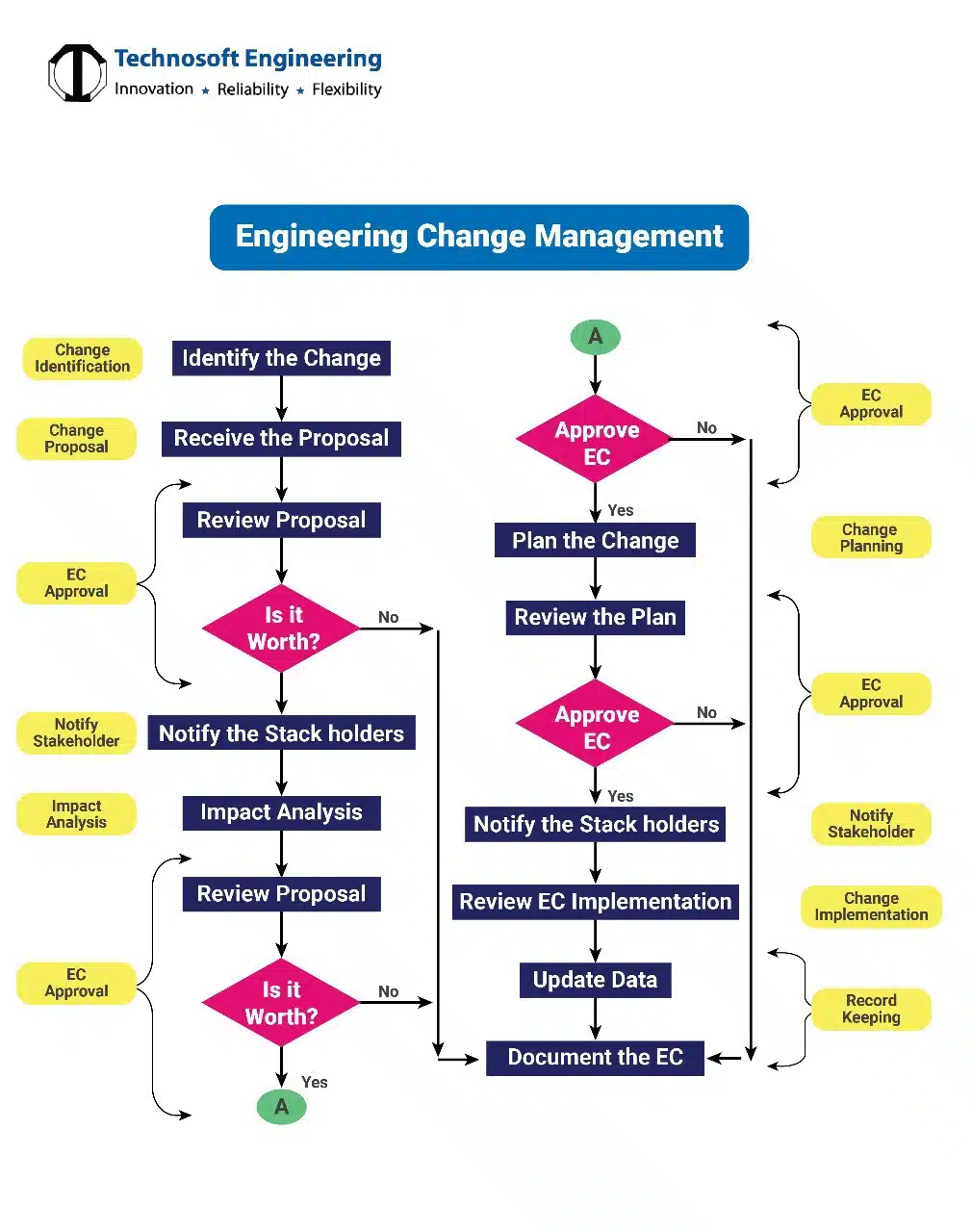
Change is inevitable, especially in the dynamic landscape of engineering projects. A critical aspect that engineers and project managers navigate daily is the management of changes that occur during the lifecycle of a project. Engineering change management is the structured process that orchestrates these modifications while ensuring the project’s integrity, timelines, and budget are upheld. Embracing best practices in this realm is pivotal for seamless operations and successful outcomes.
Overview – Best Practices for Engineering Change Management
Best practices in ECM encompass various strategies and methodologies that help streamline the change process while maintaining quality and compliance. Here’s a detailed overview:
1. Establish Clear Change Management Procedures:
Begin by defining comprehensive procedures outlining how changes are proposed, evaluated, approved, and implemented. This includes identifying stakeholders, roles, responsibilities, and the workflow for change requests.
2. Document Everything:
Maintain detailed documentation of the proposed change, its impact analysis, and the rationale behind it. This documentation should include technical specifications, risk assessments, cost implications, and schedules.
3. Change Impact Assessment:
Before implementing any change, conduct a thorough impact assessment to understand how it will affect various aspects such as functionality, performance, cost, schedule, and compliance. This helps in making informed decisions.
4. Risk Analysis and Mitigation:
Evaluate potential risks associated with the proposed change and develop mitigation strategies to address these risks. Assess the impact on existing systems, workflows, and dependencies to minimize any negative consequences.
5. Cross-Functional Collaboration:
Involve cross-functional teams and stakeholders in the change management process. Communication and collaboration among different departments (engineering, production, quality assurance, etc.) are critical for successful change implementation.
6. Change Control Board (CCB):
Establish a CCB comprising key stakeholders who review, prioritize, and approve/reject change requests based on predefined criteria. The CCB ensures that changes align with organizational goals and standards.
7. Test and Validation:
Perform rigorous testing and validation of the proposed change in controlled environments or through simulations before full implementation. This helps in identifying potential issues and ensures that the change meets desired outcomes.
8. Fallback Plans:
Prepare contingency plans or fallback options in case the implemented change does not produce the expected results or causes unforeseen issues. This allows for a swift response to mitigate disruptions.
9. Change Communication:
Communicate effectively with all relevant parties about approved changes, their implications, and the expected outcomes. Transparency in communication helps in gaining support and minimizing resistance to change.
10. Continuous Improvement:
Review and analyze the effectiveness of implemented changes regularly. Collect feedback, learn from experiences, and use this information to continually improve the ECM process.
Implementing these best practices in Engineering Change Management fosters a systematic and controlled approach to handling modifications, ensuring that changes are well-managed, tracked, and beneficial to the overall objectives of the organization.
What Is Engineering Change Management?
Engineering Change Management (ECM) is a systematic approach used in various industries, especially manufacturing and product development, to control and manage modifications or alterations made to products, processes, or systems after their initial design and implementation. It involves handling changes efficiently while ensuring minimal disruption to the ongoing operations and maintaining the integrity of the final product.
What is an ECN or ECO in Manufacturing?
In manufacturing, an ECN (Engineering Change Notice) or ECO (Engineering Change Order) refers to a documented process used to propose, evaluate, approve, and implement changes to a product’s design, specifications, or manufacturing processes. These changes might be necessitated by various factors, such as design flaws, component availability, cost reduction, compliance requirements, or quality improvements.
Here’s a breakdown of the components and the process involved in an ECN/ECO:
1. Initiation:
The need for change is identified by various stakeholders, such as engineers, designers, quality control personnel, or even customers who might report issues or suggest improvements.
2. Documentation:
An official request is created, detailing the proposed changes. This document includes specifics about the problem or improvement, the suggested solution, potential impacts on cost, timeline, and any required resources.
3. Evaluation:
A cross-functional team reviews the proposed change to assess its feasibility, impact on product performance, cost implications, manufacturing feasibility, and potential effects on other parts of the product or production process.
4. Approval:
Once evaluated, the proposed change is presented to relevant decision-makers for approval. This might involve managers, engineers, quality assurance personnel, and other key stakeholders. Approval ensures that the change aligns with the company’s goals and standards.
5. Implementation:
Upon approval, the change is integrated into the product’s design or manufacturing process. This step involves updating technical drawings, specifications, manufacturing instructions, software codes (if applicable), and any other relevant documentation.
6. Verification and Validation:
After implementation, the modified product or process undergoes testing and validation to ensure that the change effectively addresses the identified issue or improvement without causing any adverse effects.
7. Documentation Update:
All related documents, including technical drawings, bills of materials, and quality control procedures, are updated to reflect the approved change. This ensures that future production or maintenance is based on the most current specifications.
ECNs/ECOs are critical in maintaining product quality, improving efficiency, meeting regulatory requirements, and responding to customer feedback. They help ensure that any changes made to a product or its manufacturing process are thoroughly assessed, approved, and properly documented to maintain consistency and quality standards throughout the product lifecycle.
What is an Engineering Change Request (ECR) in Manufacturing?
An Engineering Change Request (ECR) in manufacturing refers to a formal proposal or documentation submitted by engineers or stakeholders within a company to suggest alterations or improvements to a product, process, or system. ECRs are typically initiated to address issues such as design flaws, quality concerns, cost reduction opportunities, regulatory compliance adjustments, or enhancements in functionality.
The ECR process involves outlining the proposed changes, justifying the need for them, assessing potential impacts (such as cost, time, resources, and production schedules), and obtaining approvals from relevant parties, such as engineering teams, quality control, production managers, and stakeholders. Once approved, an ECR often leads to the creation of an Engineering Change Order (ECO) that details the specific modifications to be implemented.
ECRs are crucial in maintaining product quality, ensuring compliance, and continuously improving products and processes throughout their lifecycle in manufacturing industries. They help companies adapt to market demands, rectify issues, and innovate while managing the potential impacts of changes on production and resources.
What does an ECR in manufacturing include?
An Engineering Change Request (ECR) is a formal document that is used to propose and manage changes to products, processes, or documentation in a manufacturing environment. It serves as a communication tool to clearly outline the proposed change, its rationale, potential impacts, and the necessary approvals for implementation.
Key Elements of an ECR:
- Problem or Improvement Statement: Clearly defines the issue or area for improvement that the ECR is addressing.
- Proposed Change: Describes the specific change being suggested, including any modifications to designs, specifications, or procedures.
- Reason for Change: Provides a detailed explanation of why the change is necessary, highlighting the benefits or drawbacks it may bring.
- Affected Items: Identifies all components, processes, or documentation that will be impacted by the proposed change.
- Cost and Resource Estimation: Assesses the potential costs and resource requirements associated with implementing the change.
- Impact Analysis: Evaluates the potential impact of the change on various aspects, such as quality, safety, performance, and cost.
- Approvals: Includes spaces for signatures and approvals from relevant stakeholders, such as engineers, managers, and quality assurance personnel.
What Are The Engineering Change Management Processes & Best Practices
The process of Engineering Change Management typically involves several stages and best practices to ensure efficient and effective handling of changes while minimizing potential negative impacts. Here’s a breakdown of the key elements:
1. Identification of Change:
The process begins with identifying the need for change. This could come from different sources like customer feedback, internal assessments, market trends, or regulatory updates. It’s crucial to clearly define the problem or opportunity for change.
2. Documentation and Analysis:
Once identified, the change request needs to be documented comprehensively. This documentation includes details about the proposed change, its rationale, potential impact on various aspects (cost, time, resources, quality), and the expected benefits. Engineers and relevant stakeholders analyze this information thoroughly to evaluate the feasibility and implications of the proposed change.
3. Evaluation and Approval:
A formal evaluation process involves assessing the proposed change’s technical feasibility, cost implications, potential risks, and impact on existing systems or processes. Based on this evaluation, a decision-making body or change control board reviews and approves/rejects the proposed change. Clear criteria for approval need to be established beforehand to maintain consistency.
4. Implementation Planning:
Once a change is approved, a detailed plan is formulated. This plan outlines the steps, resources, timelines, responsibilities, and communication strategies required for successful implementation. It’s essential to ensure that all stakeholders are informed and aligned with the implementation plan.
5. Testing and Validation:
Before full-scale implementation, changes often undergo testing and validation phases. This involves prototype testing, simulations, or trials to verify that the proposed changes meet the intended objectives without negatively impacting the existing systems or performance.
6. Implementation:
After successful testing, the approved changes are implemented into the existing product, system, or process. Careful monitoring during this phase is critical to address any unexpected issues promptly.
7. Documentation and Communication:
Throughout the entire process, comprehensive documentation of every stage is crucial. This includes maintaining records of change requests, approvals, implementation details, test results, and final outcomes. Effective communication ensures that all relevant stakeholders are aware of the changes and their impacts.
What Are Some Of The Best practices in Engineering Change Management include:
1. Standardization:
Establishing standardized procedures and protocols for initiating, evaluating, and implementing changes.
2. Cross-functional Collaboration:
Involving various stakeholders (engineering, production, quality assurance, etc.) throughout the change process to ensure diverse perspectives and expertise.
3. Risk Assessment:
Conducting thorough risk assessments to anticipate and mitigate potential negative impacts of changes.
4. Version Control:
Maintaining clear version control of designs, documents, and specifications to track changes accurately.
5. Continuous Improvement:
Regularly reviewing and refining the change management processes based on past experiences and feedback.
Effective Engineering Change Management processes are crucial for maintaining product quality, innovation, and adaptability in dynamic environments, ensuring that changes are implemented smoothly without disrupting operations or compromising the integrity of the product or system.
Conclusion
In conclusion, implementing effective engineering change management practices is crucial for maintaining product quality, meeting customer demands, and ensuring efficient operations within an organization. By establishing clear processes, fostering communication among stakeholders, prioritizing changes based on impact analysis, and leveraging robust documentation, companies can navigate change seamlessly while minimizing risks and maximizing innovation.



Comments are closed